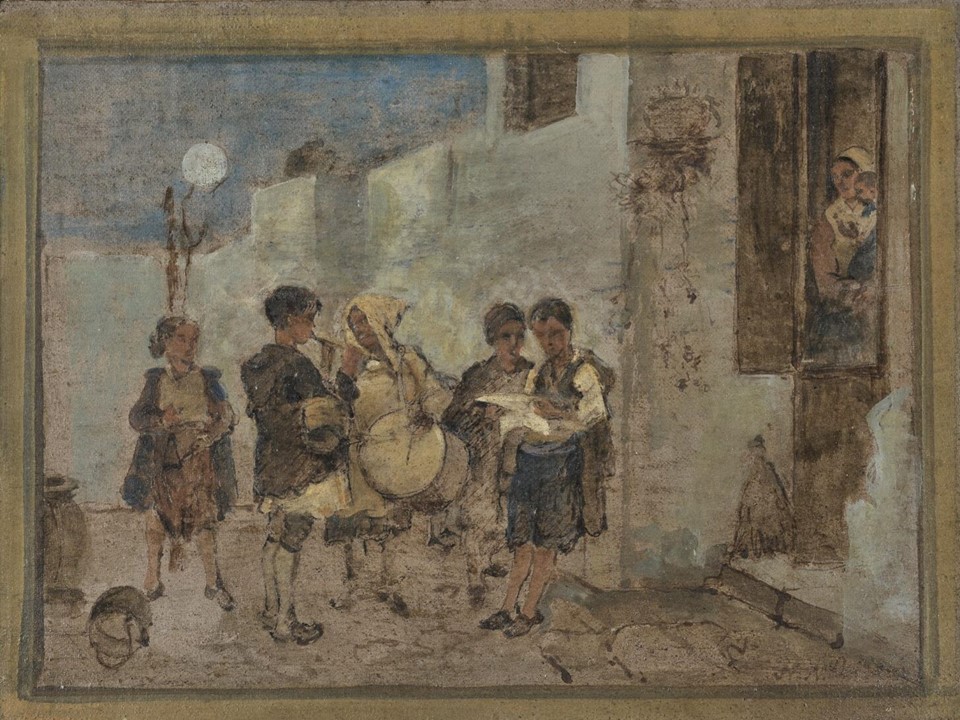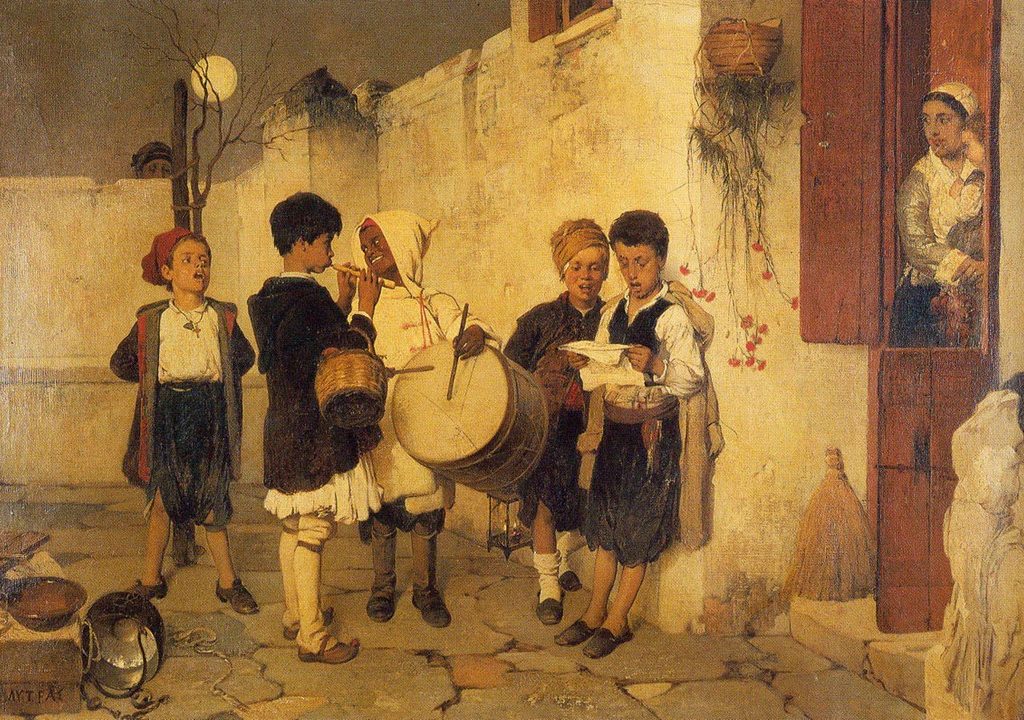
Study for Τα Κάλαντα (Carols), 1870s, Oil on Cardboard, 17,3 x 22,5 cm, National Gallery – Alexandros Soutsos Museum, Corfu Annex, Greece
https://www.nationalgallery.gr/en/artwork/study-for-carols/
Good Evening Kings, / if it’s your will / the divine birth of Christ / I’ll sing in your mansion. / Christ is born today, / in the city of Bethlehem, / the heavens are rejoicing, / all the nature rejoices. / Inside the cave is being born, / in a manger of horses, / The King of heavens / The Creator of all. / In this house, we’ve come / may no stone ever crack, / and the master of the house / may live for many years! Carols, known as Kalanta in Greek, are a beloved tradition for children worldwide. In Greece, during the Christmas season and New Year, Kalanta is joyously sung by children with great enthusiasm and gusto. This festive scene is precisely captured in our Christmas Eve BLOG POST titled… Study for Ta Kalanta by Nikephoros Lytras. https://hcc.edu.gr/greek-christmas-carols-meaning-and-translations/
This is an iconic work in Greek art, created in the 1870s while Lytras was Professor of Painting at the National Technical University in Athens. The painting, a genre scene inspired by Greek culture, is characteristic of Lytras’ style, which reflects the influence of the School of Munich. It combines academic principles, a realistic and detailed representation of what is presented, and a romanticized approach to the genre subject matter, a group of children singing Kalanta, the festive tradition during the Holidays Season.
The painting I am presenting, Study for Ta Kalanta by Nikephoros Lytras, is exhibited in the Corfu Annex of the National Gallery – Alexandros Soutsos Museum of Greece. It is, as the title connotates, a ‘Study” of the iconic larger oil on canvas painting by Lytras, Ta Kalanta, held in a private collection. Both paintings, apart from capturing a festive moment in Greek tradition, reflect the broader artistic and cultural movements of their time.

Τα Κάλαντα (Carols), 1872, Oil on Canvas, 59×90 cm, Private collection https://commons.wikimedia.org/wiki/File:Lytras_Nikiforos_Carols.jpeg
Both paintings depict a group of five children in traditional attire, singing Kalanta in the rhythm of the drum and the flute. They are not alone. In front of the open door of a humble household, the five protagonists are watched by a young mother, cradling a baby in her arms. Interestingly, a sixth boy is added in the final version of Ta Kalanta. He emerges from behind the high fence wall, next to the courtyard’s leafless tree, gazing with curiosity at the unfolding scene of merriment.
Nikephoros Lytras masterfully crafted a scene of fading light, with the moon ascending in the sky and a small lantern flickering in the firm grip of one of the performers. This comes as no surprise, given that during Lytras’s era, children would sing carols after sunset, a tradition that continues to thrive in numerous rural regions of Greece to this day.
The artist intends to convey more than what I have already presented. In both of his paintings, a rich tapestry of symbolism unfolds. The mother’s offering of pomegranate fruits symbolizes not only rebirth but also abundance. The presence of a straw broom by the door and a leafless tree in the courtyard serves as a poignant representation of hardships and poverty, yet it carries an underlying message of hope for brighter days ahead. Adjacent to the other side of the door, an ancient Greek sculpture of a Nike figure hints at the enduring strength of the Greek people, serving as the foundation for future growth and fortune.
Both paintings of Τα Κάλαντα are regarded as masterpieces within Lytras’ body of work, exemplifying his capacity to seamlessly integrate technical expertise with a profound comprehension of Greek culture. By skillfully depicting children as the bearers and preservers of Greek cultural legacies Lytras connects the past with the present and sends the joyful message of camaraderie of all people, defying limitations, and discrimination. Celebrated for their emotional resonance, these artworks highlight the artist’s dedication to encapsulating the essence of Life.
Χρόνια Πολλά και πάντα ΚΑΛΑ!!!
For a PowerPoint titled 14 Masterpieces by Nikephoros Lytras, please… Check HERE!